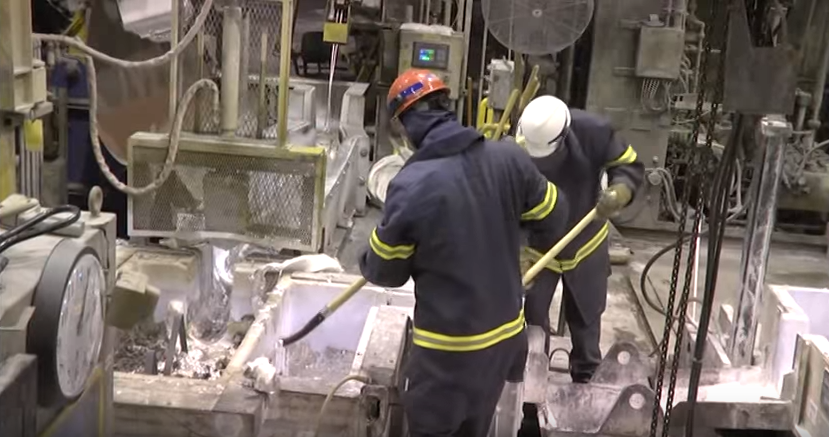
Folks like Cheryl Husk depend on the factory for work. The military depends on it, too.
The blue-collar town of Hawesville, Ky., is home to less than 1,000 people. But don’t let its size fool you — Hawesville is also home to an essential part of America’s defense industrial supply chain.

The Century Aluminum plant in Hawesville is one of just five primary aluminum smelters remaining in the United States. It is the only one, however, with the capacity to make the high-purity aluminum needed by the U.S. military to build fighter jets like the F-35.
And people like Cheryl Husk make it happen.
Husk has worked at Century Aluminum for the past 21 years. The mother-of-two also serves as the recording secretary for United Steelworkers Local 9423, helping the union provide protection and care for its members in what can be back-breaking work.
“The pay is good, we have good benefits and we’ve got good health insurance so that when something does happen, you don’t have astronomical medical bills to put you in debt,” Husk said. “We’ve got a pension and an optional 401k plan. I just hope the plant stays open long enough so I can take advantage of that at a younger age.”
Husk’s fears are warranted. The Century Aluminum facility in Hawesville is at risk of closing — which would be a major blow not only to residents of the small Kentucky town but also to America’s ability to access the critical supplies it needs, especially in times of conflict.
Thousands of aluminum workers have lost their jobs across the country as 17 aluminum plants have closed since 2000. The cause of this disruption, as is the case with the U.S. steel industry, is that China and other foreign countries that are dumping unfairly traded aluminum into the U.S. market priced far below fair market value.
Just before he left office in January, former President Barack Obama filed a World Trade Organization complaint alleging that China’s unfair subsidies to its aluminum makers was creating excess capacity, undercutting American workers and businesses that play by rules and operate in a free market.
That case continues to make its way through the WTO. Meanwhile, the Trump administration launched a highly publicized Section 232 investigation into whether aluminum imports are a threat to national security, noting that losing our ability to manufacture high purity aluminum will severely weaken our defense industrial base.
Commerce Secretary Wilbur Ross specifically cited the Hawesville facility as part of the justification for the Section 232 investigation, noting that U.S. combat aircraft such as the Lockheed-Martin F-35 joint strike fighter and the Boeing F/A-18 Super Hornet require high-purity aluminum that is now solely produced at the Century Aluminum plant.
Ross said that Century could probably meet U.S. peacetime needs, but not if America needs to ramp up production for a military conflict. This same high-purity aluminum goes into armor plating for military vehicles and navy vessels.
“At the very same time that our military is needing more and more of the very high-quality aluminum, we’re producing less and less of everything, and we only have the one producer of aerospace-quality aluminum,” Ross said recently.
Results of the investigation are expected within the coming weeks. Depending on the findings, President Trump could issue tariffs in response.
“If something doesn’t change we are going to lose these jobs, and not just right here in my county, but at all the smelters in the United States.” Cheryl Husk
In any case, there’s little doubt for Husk that China’s continued dumping of aluminum has been devastating for Hawesville.
“The aluminum industry really tanked in 2015,” said Husk. “That’s when we had the biggest part of our layoffs. Before the layoffs, we had 550 hourly workers and now we’re down to about 200.
“It’s been huge. We had five lines running but now we just run two. A little over a third of our plant is still active. It’s had a huge impact on the [union] local and the community with the loss of all the jobs.”
Husk began working at Century Aluminum at 22 after a short stint as a college basketball player. At 6-feet, 4-inches, the mother of two was recruited by Century.
“They were looking for some women, and our county is such a small county that everybody knows everybody, so somebody had mentioned my name because they were pretty sure I could handle the work,” said Husk, now 43. “They had actually called me when I was pregnant with my daughter and asked me to come in for an interview. It told them I was pregnant and couldn’t work at the time so they said they would call me back. I was thinking I would never hear from them, but, yeah, they did call me back.
“So, I went down and got hired. There is nowhere else you could go out of high school with no education and be paid this well.”
Husk has had her share of burns, broken elbows, bangs and bruises over the years while raising son Derek, 23, and daughter Kristin, 21, but her seniority has safely kept her from being laid off.
Others haven’t been so lucky.
“With all the layoffs, we’ve had a lot of rollbacks where older people get rolled back into harder jobs they just can’t handle as well anymore. We all work overtime so it is strenuous. People just quit,” she said. “We’ve had members who have lost their homes, members that have lost cars. We’ve actually had two suicides in the last two years. I can’t say for sure it was because of their jobs, but both men were rolled back to the potline, the hottest, hardest part of the plant. It’s just tough work.”
The smelting of aluminum is like electrolysis. The beginning of the process requires a series of cells that are connected in what is called a potroom. Required to make the aluminum are alumina, carbon anodes and copious amounts of electrical current.
In the rodding room, where Husk works, rods that have helped produce hot, liquid aluminum are cleaned and equipped with a new carbon block before being sent back to the potroom to produce more aluminum.
“We send the carbon blocks, which are anodes, back to the potroom,” said Husk. “Anodes and cathodes are in the same pot and the pots are connected in a series. Alumina is a powder that goes in. They go into the pots and the electrical power goes through the anodes to the cathode while the alumina is suspended in a cryolite bath.”
The carbon block is the anode. It sits in a pot in a cryolite liquid bath. The aluminum ore is suspended in the cryolite bath and electricity is shot from the anode through the liquid bath to the cathode at the bottom of the pot. This causes the ore to turn to aluminum. The liquid bath temperature hovers around 1,100 degrees.
“The electricity causes a reaction and it turns the ore into metal,” said Husk. “It is basically a simple way to do it. You have liquid cryolite bath and you’ve got aluminum ore. Basically, that’s it. We don’t alloy ours. We have very pure liquid aluminum so we don’t alloy it at all. Our aluminum is 99.9-something pure.”
“It’s a simple process and has been done this way for years. There is a lot of crane work. Computers have helped though. When I hired in we had one computer running 112 cells. Now each cell has its own computer.”
Hawesville is located on the Ohio River just across from Cannelton, Indiana. It is considered part of the metropolitan area of Owensboro, Kentucky. For major city activities, Louisville is about an hour-and a half drive from Hawesville.
For such a small city, Century Aluminum has been essential in providing middle-class lifestyles for Hancock County residents. Any further slowdown or shutdown will not only devastate surrounding communities but also put America’s national defense at a greater risk.
“People here almost have to realize the trade impact,” said Husk. “We started off the year in 2015 with aluminum doing well but just all of a sudden the bottom fell out. Of course, the Chinese were dumping. It wasn’t long after they found all the aluminum in Mexico that they were trying to skirt across the border. So, it was fairly obvious to us once the reports started coming in. We can’t compete with a plant that is being subsidized by its government.
“If something doesn’t change we are going to lose these jobs, and not just right here in my county, but at all the smelters in the United States.”
Husk hopes to see effective action that will save jobs like hers.
“There is another generation coming up that needs to raise their kids and so the industry needs to be saved,” she said. “And I just don’t mean aluminum. Steel does, too. The auto industry and so many others.
“Aluminum is the one I work in, so it’s near and dear to my heart.”
